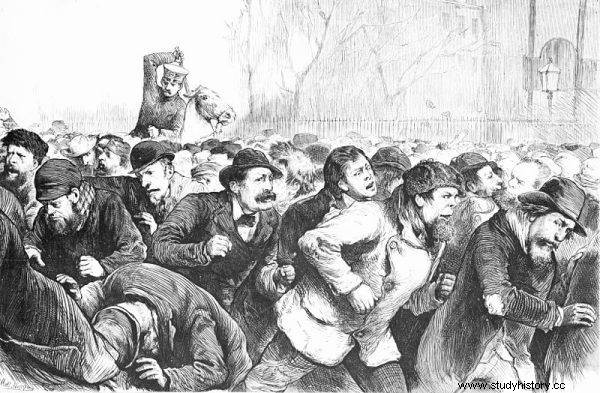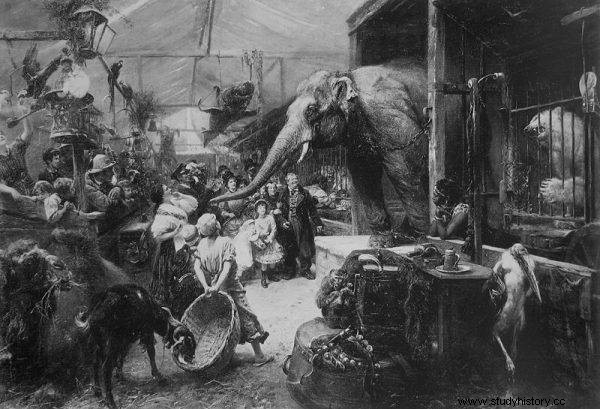On November 9, 1874, New York paralyzed an article in the New York Herald. The headline on the front page shouted, "Wild animals escaped Central Park!".
A six-column text related to the terrifying situation that unfolded in the streets of the city. People panicked and began to barricade houses. The men went hunting to save their families from being eaten by wild beasts. Journalists set off in search of sensation. The event itself became for all New Yorkers… a lesson for the future.
Don't tease the rhino
It all started, the Herald reported, with a reckless ranger who provoked the rhino by teasing him through the bars of the cage with a stick. The enraged beast crushed the fence and fled, killing its guardians along the way. In a frenzy, she also knocked down the cages of other animals, and these scattered around the city, wreaking havoc. The text was filled with terrifying details from eyewitness testimonies describing the horrors of these events:
Retreating from its massacred body with incredible speed, the rhino stabbed its terrifying horn into the dead guard ...

According to an article in Herald, Dantesque scenes took place in a quiet zoo in Central Park
The panther crouched over Hyland's body, biting the man's head. I recognized his body by the striped shirt that hung over his shoulder ...
Men and women rushed in all directions, away from the beast, which jumped on the shoulders of the old woman. She sank her fangs into her neck and threw her to the ground.
City in panic
There were fights between animals in the streets. Tigers attacked lions, anaconda tried to strangle a giraffe, and Swedish hunters tracked a lion on Broadway. In one church there was a panther attacked and another wild cat terrorized the passengers on the ferry. The police and the national guard heroically fought the beasts, but unfortunately 49 people were killed and 200 were injured. Governor John Adams Dix was to personally shoot a Bengal tiger roaming Madison Avenue. Unfortunately, despite these efforts, some animals were still in the wild, waiting for the lives of innocent and unsuspecting passersby.

A six-column text related to the terrifying situation that unfolded in the streets of the city. People panicked (illustrative illustration)
Many people panicked after reading the article, and the city's mayor himself, William Frederick Havemeyer, asked all residents to barricade themselves in their homes until wild animals were caught. However, not everyone followed this recommendation.
Armed men ran to the streets, ready to defend their families. Reporters set out into the city in pursuit of new information and juicy stories and mothers hurriedly brought their children home from school. Even the police began to mobilize. However, there was one small snag that would have avoided the whole situation.
Small Print
It was enough to read the article to the end to find out that the escape of animals from Central Park is one big hoax:
The whole story given above is pure fabrication. Not a single word is true. Not a single deed or incident described has taken place. This is a grand hoax, a mad affair, or any other epithet of total unbelief that our readers may choose to apply . It's just a fancy image that stuck in the writer's mind a few days ago as he stared through the iron bars of the wildlife cages in the Central Park Menagerie.

With his text, the journalist wanted to draw attention to the poor conditions in which the animals were kept (illustrative illustration).
Nineteen years later, author Thomas Connery recalled the madness he had caused:“In a hoax, John A. Dix was depicted shooting a Bengal tiger. Indeed, he set off on publication day armed with a rifle, firmly believing that the story in the New York Herald was true and that danger could be lurking around every corner. " The journalist said that the editor of the New York Times ran out of the house, waving two pistols in the air, ready to shoot the first animal he encountered. He was also supposed to go outraged at the police station and protest against the transmission of information exclusively to "Herald".
What was the real purpose of this hoax? As Connery himself later stated in an interview with Harper's Weekly, he wanted to draw attention to the poor conditions in which the animals were kept in the zoo. "The whole story was meant to be a harmless joke, realistically portrayed as a salutary warning."
Bibliography
- Brooke-Hitching, The Madman's Library. The greatest publishing curiosities , Rebis, 2020.
- The Central Park Zoo Escape , hoaxes.org / accessed on November 28, 2021.
- Mitchell, 'A carnival of death' on New York's streets:The newspaper hoax that panicked a city , washingtonpost.com, 13/06/2017 / accessed:28/11/2021.
